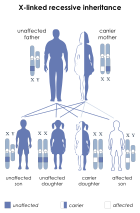Properdin deficiency
Introduction
| Properdin deficiency | |
|---|---|
 | |
| This condition is inherited in an x-linked recessive manner |
Properdin deficiency is a rare X-linked disease in which properdin, an important complement factor responsible for the stabilization of the alternative C3 convertase, is deficient.[1] One of the first studied cases of properdin deficiency was in 1980 by Davis and Forrestal.[2] These families had members with only partial deficiencies which resulted in a lowered consumption of the C3 protein.[2] Properdin deficiency was studied again shortly after in 1982 by Sjoholm in which all of the subjects were deceased shortly after the study because of their disease.[2] The largest study of properdin deficiency was in 1989 by Fijen which included 9 males across 3 generations.[2] Out of the 46 family members in Fijen's study, the 9 who were affected were found to be more susceptible to fulminant meningococcal disease.[2]
Signs and Symptoms
As a protein involved in the function of the immune system, no external changes in physiology or aberrant physical characteristics are expressed by individuals possessing a properdin deficiency. However, individuals that have a properdin deficiency do have a heightened susceptibility to bacterial infections, most notably caused by bacteria within the Neisseria genus, though there have also been studied cases of individuals with recurrent pneumococcus bacteremia as a result of Streptococcus pneumoniae, another species of bacteria from an entirely different phylum.[2][3] Due to a heightened susceptibility to Neisseria bacterium, individuals with properdin deficiency are far more likely to succumb to bacterial infection such as meningitis, resulting in inflammation of the brain and spinal cord, which causes severe headaches, fevers, and neck stiffness, and may result in further development of other meningococcal diseases and extreme complications such as sepsis.[4] Individuals with properdin deficiency are also more likely to catch the sexually transmitted disease, gonorrhea, as it is also caused by Neisseria bacterium, resulting in swelling, itching, pain, and formation of pus on the mucous membranes, including, but not limited to, the genitals, mouth, and rectum.[5]
References
- ^ van den Bogaard R, Fijen CA, Schipper MG, de Galan L, Kuijper EJ, Mannens MM (July 2000). "Molecular characterisation of 10 Dutch properdin type I deficient families: mutation analysis and X-inactivation studies". Eur. J. Hum. Genet. 8 (7): 513–8. doi:10.1038/sj.ejhg.5200496. PMID 10909851.
- ^ a b c d e f "OMIM Entry - # 312060 - PROPERDIN DEFICIENCY, X-LINKED; CFPD". www.omim.org. Retrieved 2022-03-23.
- ^ Sexton, Daniel J. "Invasive pneumococcal (Streptococcus pneumoniae) infections and bacteremia". www.uptodate.com. Retrieved 2022-03-24.
- ^ "Meningitis", Wikipedia, 2022-03-20, retrieved 2022-03-24
- ^ "Gonorrhea", Wikipedia, 2022-03-22, retrieved 2022-03-24
External links
